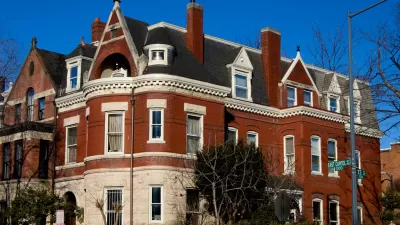Washington D.C. is experiencing a "rush" on new construction of renovated townhouses or "pop-ups," which many say do not fit the character of the neighborhoods where they tend to proliferate.

Ian Shapira reports on the increasing presence of "pop-ups" in Washington D.C. For those unfamiliar with the term, Shapira describes pop-ups as "skyscrapers in small villages: renovated townhouses — but between 40 and 65 feet high — right next to squat, two-story rowhouses in Washington neighborhoods from Petworth to NoMa to Adams Morgan.
"These skyward-extending residences are spreading across the city, fueled by small developers eager to cash in on the District’s real estate boom and seize any inch of available real estate, which these days means vertical empty space. Though developers have the right to build upward — and say they are providing needed housing stock — the city is evaluating how it can ensure that pop-ups in some neighborhoods reflect their community’s character."
Along those land use regulation lines: "The D.C. Office of Planning was expected on Friday to publicly release proposals on pop-ups, said Jennifer Steingasser, the office’s deputy director. Her office has been examining whether the current 40-foot maximum height is 'appropriate' for some neighborhoods in residential zones. The Zoning Commission will review the proposal. It would have to approve any new regulations on pop-ups, but a vote isn’t expected to happen for several months."
For more examples of pop-ups and other hyper-local news in Washington D.C., see the PoPville website.
FULL STORY: D.C. developers take rowhouses to new heights

Alabama: Trump Terminates Settlements for Black Communities Harmed By Raw Sewage
Trump deemed the landmark civil rights agreement “illegal DEI and environmental justice policy.”

Planetizen Federal Action Tracker
A weekly monitor of how Trump’s orders and actions are impacting planners and planning in America.

How Atlanta Built 7,000 Housing Units in 3 Years
The city’s comprehensive, neighborhood-focused housing strategy focuses on identifying properties and land that can be repurposed for housing and encouraging development in underserved neighborhoods.

In Both Crashes and Crime, Public Transportation is Far Safer than Driving
Contrary to popular assumptions, public transportation has far lower crash and crime rates than automobile travel. For safer communities, improve and encourage transit travel.

Report: Zoning Reforms Should Complement Nashville’s Ambitious Transit Plan
Without reform, restrictive zoning codes will limit the impact of the city’s planned transit expansion and could exclude some of the residents who depend on transit the most.

Judge Orders Release of Frozen IRA, IIJA Funding
The decision is a victory for environmental groups who charged that freezing funds for critical infrastructure and disaster response programs caused “real and irreparable harm” to communities.
Urban Design for Planners 1: Software Tools
This six-course series explores essential urban design concepts using open source software and equips planners with the tools they need to participate fully in the urban design process.
Planning for Universal Design
Learn the tools for implementing Universal Design in planning regulations.
Caltrans
Smith Gee Studio
Institute for Housing and Urban Development Studies (IHS)
City of Grandview
Harvard GSD Executive Education
Toledo-Lucas County Plan Commissions
Salt Lake City
NYU Wagner Graduate School of Public Service




























